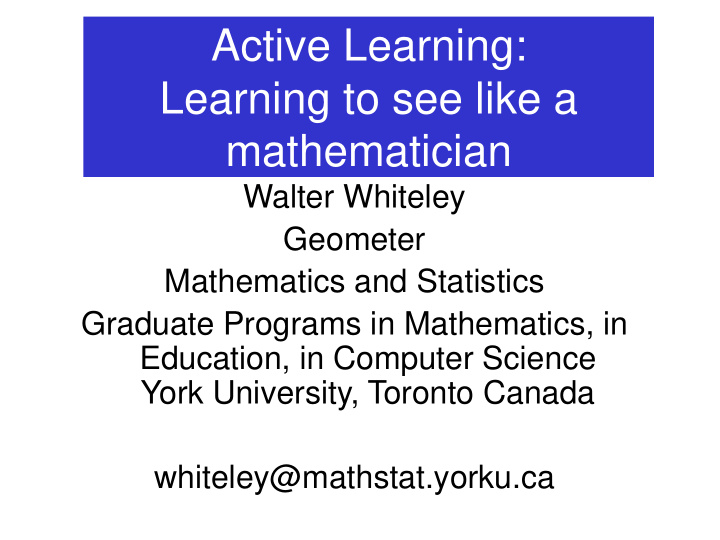



Active Learning: Learning to see like a mathematician Walter Whiteley Geometer Mathematics and Statistics Graduate Programs in Mathematics, in Education, in Computer Science York University, Toronto Canada whiteley@mathstat.yorku.ca
Some claims to be considered • What you see is central to how you reason, problem solve; • We learn to see (and change what we see) • Novices need to learn to see like experts see; • 3-D visual processing is distinct from 2-D visual processing; • Kinematic experiences are linked to 3-D visual processing - and to mathematics • I wish the same options for my students.
Private face / Public face • I do my mathematics visually, • and kinesthetically, in private. • Choosing when and how I use spatial reasoning has: changed the questions I pose; changed the methods I use; changed the answers I give; changed my communication and my teaching.
Mathematics with Eye and Hand: • Mathematics is done in the brain • eye is part of the brain, made external. • eye and hand are linked in the brain: eye-hand coordination; planning in the brain; strongly linked to emotion; • which tools and activities build mathematics? • links to visual, spatial and kinesthetic • Specific experiences in 3-D.
A mathematician sees … with images A macaque monkey was trained to stare at this pattern. Injected radioactive sugar to highlight blood flow. ‘ Sacrificed ’ while staring at the image This is an x-ray picture of half the visual cortex at the back of its head External and internal images share these processes
A mathematician sees … with many parts of the brain • Work with a brain developed before mathematics existed - ‘ conceptual metaphors ’ (Lakoff & Nunez). • No simple pattern of steps. • Typically not using language parts of brain. • Heavy use of visual / eye-hand parts 7 ´ 5 = ? 7 ´ 5 > 26 ? Language (multiplication table) Visual (analog number line)
A mathematician works … with many parts of the brain 58+70 = ? 58+70 = ? 320 Language (tables) Visual (analog number line) • Multiple independent pathways, • Many surprises, • Many visual steps
No! Do you see what I see? We process, select, and construct what we see. We create what we see Motion 1 Motion 2
We create what we see We can change what we see • Students don ’ t see what we see! • In mathematics we create what we see: from experience: eyes and hands from practice and apprenticeship; from insight and understanding. If I teach to you see like a mathematician, then mathematics will be easy
Symmetries in 3-Space • Polyhedra - virus abstract images • core concept of physics, chemistry, geometry, ...
A mathematician sees … logic Metaphors and Transfer • Consider: • All A are B • All B are C • Therefore All A are C • Is this language based? No B A C Vinod Goel, Lakoff and Nunez
Spatial Reasoning is Essential • Visual/Spatial reasoning is central to how you reason, problem solve; • We learn to see (and change what we see) • 3-D spatial reasoning is central – don’t flatten the spatial child into the plane! • Spatial reasoning is essential to doing mathematics • Necessary for some students to access math • Strengthens even the best students in math (and science).
Spatial Reasoning is a Gap at University Entrance • Documented issue for first year engineers • Weak spatial reasoning, without catch-up, • predicts poor performance and low retention to second year • “Engage” engineering web site • impact on first year science, including calculus • Is identified as source of anxiety by pre- service and in-service teachers • Is malleable: can be developed at all ages.
3D - not 2-D
We need a mix of approaches • We remember about 10% of what we read; • We remember about 30% of what we hear; • We remember about 80% of what we see and do. Jerome Bruner • We will forget 80% of what we learn today.
A mathematician sees … with a complex brain A ‘ simplified map ’ of pieces and connections. Note: two way arrows - paths also used for images in the mind ’ s eye Main message is complexity! Kosslyn
Possible Lessons from PISA • From Shanghai • High quality continuous professional development • teachers of math and science in early years • From Finland • High quality pre-service preparation of teachers • Treated as professionals. • Together – they are working to improve • Are we?
A mathematician sees … in 3 -D • 2-D pictures of 3-D are ambiguous. • we may “ flip ” from one view to another. Animated Cube
Geometry with eye … that learned to see We assume that light comes from the top
A mathematician sees … Visual Addition Yellow is 1/4 of whole Yellow is 1/4 +(1/4) 2 Yellow is Yellow is 1/4 +(1/4) 2 +(1/4) 3 1/4 +(1/4) 2 +(1/4) 3 + ... = 1/3
A mathematician sees … with difficulty Problems with the use of visuals: • Inability to ‘ see ’ a diagram in different ways; • Recognizing transformations implied in diagrams; • Incorrect or unconventional interpretation of graphs; • Connection between visualization and analytic thought; • Information is determined by specific rules and conventions; • Like algebra - needs teaching and intervening conceptual thought; • Tommy Dreyfus
Recommend
More recommend